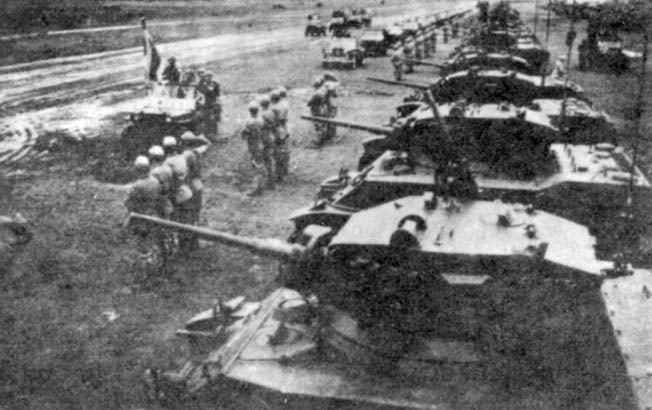marathag
Banned
British Order of battle Malaya campaign 1941-42there is only so much that could be done with no working anti-tank weapons (which has always puzzled me, the 2 pndr was not that terrible of an anti-tank gun against every light tanks/tankettes, IMO it was a munitions storage issue)
THE BRITISH EMPIRE
MALAYA COMMAND (LT. GEN. PERCIVAL)
Indian III Corps (Lt. Gen. Heath)
9th Indian Infantry Division (Maj. Gen. Barstow) 5th Field Regiment (16 4.5in. howitzers) 88th Field Regiment (24 25-pdr guns)
80th Anti-tank Regiment (two batteries) (about 18 2-pdr guns)
8th Indian Infantry Brigade (three infantry battalions; two Indian State Forces infantry battalions attached for airfield defence)
22nd Indian Infantry Brigade (three infantry battalions) 11th Indian Infantry Division (Maj. Gen Murray-Lyon)
3rd Cavalry (-)
137th Field Regiment (24 25-pdr guns)
155th Field Regiment (eight 18-pdr guns, eight 4.5in. howitzers)
80th Anti-tank Regiment (less two batteries; about 18 2-pdr guns)
6th Indian Infantry Brigade (22nd Mountain Regiment (three 18-pdr guns, ten 3.7in. howitzers) plus three infantry battalions)
15th Indian Infantry Brigade (four infantry battalions) 28th Indian Infantry Brigade (corps reserve) (three infantry
battalions)
Penang Fortress
11th Coastal Regiment (four 6in. guns) One infantry battalion
Airfield Defence Troops
Four Malay States Volunteer Force infantry battalions
8th Australian Infantry Division (Maj. Gen. Bennett)
2nd Heavy Anti-aircraft Regiment (Hong Kong Singapore Royal Artillery (HKSRA) (11 3.7in., four 3in. guns)
3rd Heavy Anti-aircraft Regiment (Royal Artillery) (nine 3.7in. guns)
1st Heavy Anti-aircraft Regiment (Indian Army) (16 3in., 26 40mm guns)
3rd Light Anti-aircraft Regiment HKSRA seven 40mm guns Three battalions Straits Settlement Volunteer Force
12th Indian Infantry Brigade (122nd Field Regiment (24 25-pdr guns) and three infantry battalions)
2/10th Field Regiment (12 18-pdr guns, six 4.5in. howitzers)
2/15th Field Regiment (3in. mortars; equipping with 18- and 25-pdr guns)
2/4th Anti-tank Regiment (12 2-pdr and 24 75mm guns) 22nd Australian Infantry Brigade (three infantry battalions)
27th Australian Infantry Brigade (three infantry battalions)
Singapore Fortress (Maj. Gen. Simmons)
1st Malaya Infantry Brigade (two infantry battalions) 2nd Malaya Infantry Brigade (three infantry battalions)
7th Coastal Regiment (two 15in. guns, three 9.2in. guns, ten 6in. guns, one 18-pdr gun, six 12-pdr, two twin 6-pdr)
9th Coastal Regiment (three 15in., two 9.2in., eight 6in., two 18- pdr, three 12-pdr, six twin 6-pdr guns)
16th Defence Regiment (two batteries 18-pdr and one battery 2-pdr coastal defence guns)
1st Heavy Anti-aircraft Regiment (Hong Kong Singapore Royal Artillery) (eight 3.7in., two 3in., eight 40mm guns)
2nd Heavy Anti-aircraft Regiment (Hong Kong Singapore Royal Artillery (HKSRA) (11 3.7in., four 3in. guns)
3rd Heavy Anti-aircraft Regiment (Royal Artillery) (nine 3.7in. guns)
1st Heavy Anti-aircraft Regiment (Indian Army) (16 3in., 26 40mm guns)
3rd Light Anti-aircraft Regiment HKSRA seven 40mm guns Three battalions Straits Settlement Volunteer Force
12th Indian Infantry Brigade (122nd Field Regiment (24 25-pdr guns) and three infantry battalions)
Major Reinforcements
45th Indian Infantry Brigade (three infantry battalions) 44th Indian Infantry Brigade (5th Field Regiment (about ten
4.5in. howitzers), one anti-tank battery (about ten 2-pdr guns), one company machine gun, three infantry battalions)
18th Infantry Division
53rd Infantry Brigade (three infantry battalions) 54th Infantry Brigade (three infantry battalions) 55th Infantry Brigade (three infantry battalions) 118th Field Regiment (24 25-pdr guns)
135th Field Regiment (ten 25-pdr guns, eight 18-pdr guns) 148th Field Regiment (24 25-pdr guns)
125th Anti-tank Regiment (36 2-pdr guns) One reconnaissance battalion
Divisional engineers
2/4th Australian Machine Gun Battalion
Guns able to do direct fire on ground targets listed in Bold
While 18pdr and 25pdr had solid AP shot, even without that, unfuzed HE projectile are likely to penetrate the thin armor of IJA tanks, of which had around 200 AFVs at the start of the campaign
